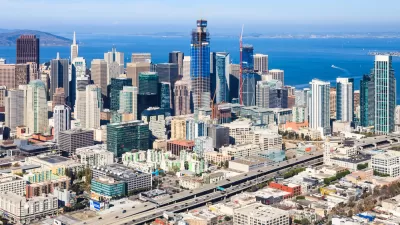Proposition E, a ballot initiative up for vote in San Francisco in May, is one of the most radical planning positions in recent years, attempting to reduce housing costs by limiting housing demand.

Joe Eskenazi reports on a game-changing proposition on the ballot in San Francisco in March, called Proposition E, which will cap the amount of office space the city can construct based on whether the city meets state-mandated affordable housing targets.
As noted by Eskenazi, Proposition E expands the powers of Proposition M, which the city approved in 1986 to cap the amount of office space in the city.
Prop. E would take things further. It would directly tie the amount of office space this city can construct to the amount of affordable housing it produces. And if the city comes up short on the latter — as it almost always does — then it will be proportionally restricted on the former.
According to Eskenazi, it's hard to imagine a San Francisco where the ballot initiative fails. "San Francisco’s electorate in March of 2020 would arguably vote for 'less office space' even without the 'more affordable housing' tie-in." The question then becomes what will happen if and when the city approves the proposition. The mayor's office is making the case that the proposition would reduce office construction and "bleed away fees intended for affordable housing." Proposition supporters point to a 2019 study that found that "fees for affordable housing reaped via the construction of office space are actually dwarfed by the affordable housing needs induced by that office space," writes Eskenazi [emphasis from the original].
A follow up article by Sarah Holder and Kriston Capps picks up on the same questions about whether the proposition will help or hurt the city's housing affordability crunch.
FULL STORY: Proposition E, barring unforeseen lunacy, will pass — handily. But then what?

Study: Maui’s Plan to Convert Vacation Rentals to Long-Term Housing Could Cause Nearly $1 Billion Economic Loss
The plan would reduce visitor accommodation by 25,% resulting in 1,900 jobs lost.

North Texas Transit Leaders Tout Benefits of TOD for Growing Region
At a summit focused on transit-oriented development, policymakers discussed how North Texas’ expanded light rail system can serve as a tool for economic growth.

Why Should We Subsidize Public Transportation?
Many public transit agencies face financial stress due to rising costs, declining fare revenue, and declining subsidies. Transit advocates must provide a strong business case for increasing public transit funding.

How to Make US Trains Faster
Changes to boarding platforms and a switch to electric trains could improve U.S. passenger rail service without the added cost of high-speed rail.

Columbia’s Revitalized ‘Loop’ Is a Hub for Local Entrepreneurs
A focus on small businesses is helping a commercial corridor in Columbia, Missouri thrive.

Invasive Insect Threatens Minnesota’s Ash Forests
The Emerald Ash Borer is a rapidly spreading invasive pest threatening Minnesota’s ash trees, and homeowners are encouraged to plant diverse replacement species, avoid moving ash firewood, and monitor for signs of infestation.
Urban Design for Planners 1: Software Tools
This six-course series explores essential urban design concepts using open source software and equips planners with the tools they need to participate fully in the urban design process.
Planning for Universal Design
Learn the tools for implementing Universal Design in planning regulations.
City of Santa Clarita
Ascent Environmental
Institute for Housing and Urban Development Studies (IHS)
City of Grandview
Harvard GSD Executive Education
Toledo-Lucas County Plan Commissions
Salt Lake City
NYU Wagner Graduate School of Public Service





























